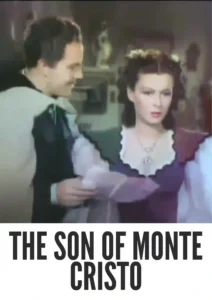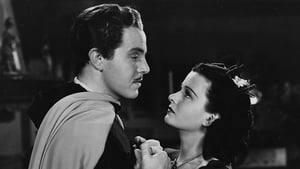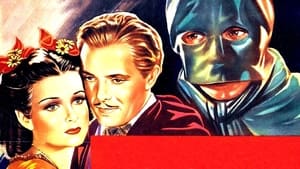Video Sources 0 Views
- Watch trailer
- The Son of Monte Cristo 1940 Colorized


Synopsis
Table of Contents
ToggleRevenge, Intrigue, and Adventure: The Son of Monte Cristo (1940) in Dazzling Color

Embark on a thrilling journey with The Son of Monte Cristo, a swashbuckling adventure from 1940, now beautifully colorized for a modern viewing experience. This film delivers action, romance, and historical drama. Perfect for fans of classic adventure films, this HD download brings a timeless tale of justice and revenge to your screen. The movie is also known as Return of Monte Cristo and The Sword Thrusts.
The Son of Monte Cristo Storyline: A Legacy of Justice
The Son of Monte Cristo follows the exploits of Edmond Dantes Jr. (Louis Hayward), the son of the legendary Count of Monte Cristo. Set against the backdrop of a turbulent Europe, the story unfolds as Edmond becomes embroiled in a dangerous plot to overthrow a tyrannical ruler.Inspired by his father’s legacy, Edmond uses his wit, skill, and courage to navigate a world of political intrigue and betrayal. Along the way, he encounters a beautiful and courageous woman (Joan Bennett) who becomes his ally and love interest. As Edmond fights for justice and freedom, he must confront powerful enemies and overcome seemingly insurmountable obstacles. The film culminates in a thrilling showdown, where Edmond puts his life on the line to expose the villainous dictator and restore peace to the land. The Son of Monte Cristo is a captivating tale of heroism, honor, and the enduring power of family.
Movie Cast
The film features a talented cast of actors who bring this adventurous story to life:
- Louis Hayward as Edmond Dantes Jr.
- Joan Bennett as Countess Paula von Rhoden
- George Sanders as Gurko
- Florence Bates as Tilly
Movie Genre
The Son of Monte Cristo falls into the genre of swashbuckling adventure, with elements of romance and historical drama. Its exciting action sequences, compelling characters, and lavish production design make it a captivating and entertaining film.
Historical Context: Adventure Films in the Golden Age of Hollywood
Released in 1940, The Son of Monte Cristo represents a high point in the golden age of Hollywood adventure films. During this period, studios produced a wealth of lavishly produced and exciting films that transported audiences to exotic locales and historical periods. The Son of Monte Cristo is a prime example of this trend, showcasing the era’s emphasis on spectacle, heroism, and romance. The film reflects the escapist mood of the time, offering audiences a thrilling distraction from the challenges of the real world.
Colorization Details
This colorized version of The Son of Monte Cristo has been meticulously restored using modern digital techniques, enhancing the visual appeal while preserving the film’s original atmosphere of adventure and excitement. The colorization process involved carefully analyzing the grayscale tones of the original black and white footage and assigning appropriate colors to each scene. This painstaking process brings new life to the characters and settings, making the story even more engaging for modern audiences. While opinions on colorizing classic films may vary, it introduces these films to a broader audience, ensuring their legacy for future generations.
Technical Details
- Director: Rowland V. Lee
- Screenplay: George Bruce, Rowland V. Lee
- Story: Alexandre Dumas père (characters)
- Cinematography: Karl Struss
- Edited by: William H. Morgan
- Production Company: Edward Small Productions
- Distributed by: United Artists
- Runtime: 102 minutes
Technical Specifications
- Download Format: MP4
- Resolution: HD (1080p)
- Compatibility: Compatible with most devices, including smartphones, tablets, computers, and smart TVs.
Reviews and Critical Reception
The Son of Monte Cristo (1940) is celebrated for its thrilling action sequences, charismatic performances, and lavish production design. The film is a prime example of classic Hollywood adventure cinema, offering audiences a captivating escape into a world of heroism, romance, and intrigue. As a beloved and enduring film, The Son of Monte Cristo remains a testament to the timeless appeal of adventure storytelling.
FAQs
- Q: What is The Son of Monte Cristo about?
- A: The Son of Monte Cristo is a swashbuckling adventure about the son of the Count of Monte Cristo, who fights against tyranny and injustice.
- Q: Is The Son of Monte Cristo (1940) a well-known film?
- A: The Son of Monte Cristo is a popular and enduring classic, known for its exciting action and charismatic performances.
- Q: Is this version of The Son of Monte Cristo colorized?
- A: Yes, this version has been professionally colorized to enhance the viewing experience.
- Q: What makes The Son of Monte Cristo interesting for classic film fans?
- A: The Son of Monte Cristo offers a prime example of classic Hollywood adventure cinema, showcasing the era’s emphasis on spectacle and heroism.
- Q: What is the download format?
- A: The download format is MP4, which is compatible with most devices.
- Q: What resolution is the download?
- A: The resolution is HD (1080p), providing a high-quality viewing experience.
Download Now in HD!
Watch The Son of Monte Cristo Today!












